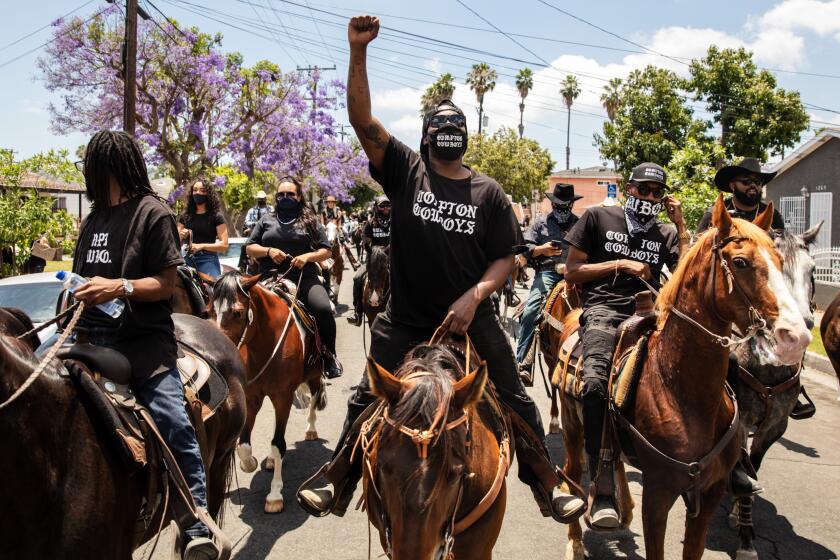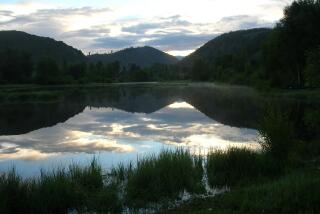Excerpt: Cowboys in Compton find hope and healing on horseback
The Los Angeles Times Book Club is reading: ‘The Compton Cowboys: The New Generation of Cowboys in America’s Urban Heartland.’ Here’s an excerpt.
I always wondered why I never learned about black cowboys in any of my elementary school classes in Huntington Park, a city in Southeast Los Angeles. The only cowboys we learned about were white. We were taught that they rode through trails, herded cattle, and occasionally got into gunfights with bandits and Native Americans. Even Mrs. Sanders, a black woman and my favorite teacher, never once mentioned black cowboys. The history of the West until that point had appeared exclusively white. Little did I know there were groups in nearby Compton who were actively trying to reinsert black cowboys into the history books.
But something always seemed a bit off. It felt like we were celebrating the lives of men who had often terrorized their way through native communities in the West. Cowboys, I would later learn, were white men who rode through towns with reckless abandon and left a trail of destruction behind them. None of it sat well with me. I was the type of kid who chose to disrupt our annual schoolwide Thanksgiving celebration in the third grade by jumping on a table and yelling that Christopher Columbus was a “murderer” and killed thousands of indigenous people throughout the Americas. The incident landed me a two-week suspension but an emphatic high-five from my then twenty-six-year-old mother, who was active in many social justice circles as a Ph.D. student in literature at the University of California, Los Angeles.
All this added up to real confusion when I first learned about the black cowboys in Compton. I was six, and my mama and I were driving to the Compton Swap Meet one Saturday afternoon. When she wasn’t reading or writing or completing her coursework, Mama worked as a valet parking attendant at a fancy hotel in Santa Monica. As a result, I spent lots of time with my aunts, who worked close to our home. Weekends were sometimes the only time when my mama and I got to see one another.
It was 1991 and we were living in a three-bedroom home that we shared with my grandmother, two aunts, uncle, and two cousins. If you lived in our neighborhood, chances were the Chicano rapper Kid Frost’s hit song “La Raza” was playing loudly on someone’s boombox or car speakers. If you lived in Watts or Compton, located about ten minutes away, you were more likely to hear an N.W.A record like “Express Yourself” or the soulful sounds of Teddy Pendergrass coming from an old head’s flashy Cadillac.
Back then, South Central and the city of Compton were in complete upheaval. Gang violence often led to high murder rates, the crack cocaine epidemic was destroying families, and rising unemployment rates were forcing black families to leave the area en masse in search of jobs and affordable housing in cities outside of Los Angeles. At the same time, Mexican immigrants fleeing dwindling economic markets in Mexico were slowly migrating to the same communities that black folks were leaving, which sometimes caused racial tensions. Black folks often blamed Mexican immigrants for stealing jobs and taking over their neighborhoods, while Mexicans — who sometimes arrived in these neighborhoods with their own preconceived ideas about blackness — often scorned their black neighbors for not working hard. Both stereotypes were rooted in deep misunderstandings and false images projected by the media.
Walter Thompson-Hernández’s “The Compton Cowboys: The New Generation of Cowboys in America’s Urban Heartland” tells a grand story in granular detail.
Whenever my mama and I drove to Compton, she would instruct me to lock our doors and make sure our windows were sealed shut as we drove across the train tracks on Alameda Street that served as a natural border between the brown community that I lived in and the black one we were driving into. Carjackings were frequent in those days and several of my relatives had been victims of different forms of robbery over the years, prompting my mama to drive with caution.
As I grew older, though, I realized that the precautions she took were often driven by deeper issues. Some of the very people whom I would call my friends and family held on to their own racist ideas about black people. Mayates, a derogatory Spanish term used to describe people of African descent, was one of the first words I ever heard referring to black people. I was receiving a message that black folks were dangerous and prone to violence, but, nevertheless, I felt a strong connection to Compton.
As the son of an African-American father whom I didn’t really meet until my early twenties, hearing these slurs directed at black people forced me to reckon with the idea that a part of my heritage could be supported while the other parts could be weaponized. I had no contact with my father and thus no contact with my black family. This made our drives to Compton more complicated than they appeared to be. I was being taught that black people were dangerous, which made me believe that I, in fact, was dangerous, but our drives also gave me the chance to dream: every time we drove to Compton, I naively believed that I might serendipitously run into my father or another black relative. My worldview was small and limited, and in my mind, Compton was the only place where black folks lived. I looked out of our car window as we drove south on Long Beach Boulevard past Martin Luther King Jr. Boulevard and under the 105 Freeway overpass and didn’t see the criminals that people in my community talked about. Instead, I saw my family.
During some of our weekend drives, I’d see Compton’s black cowboys at various intersections. Sometimes I’d see them riding their horses along the train tracks on Alameda Street that transported goods from the shipping docks in Long Beach to downtown Los Angeles warehouses, and vice versa. “Look at the black cowboys, mijo,” Mama would say as she stared in awe while waving at them on the street. I’d look at them and naively ask myself, “Are the men on these horses my family?”
We weren’t alone in our fascination. The cowboys were showstoppers. Cars would honk and drivers would wave in admiration as they trotted past. Their only competition were the classic car clubs that cruised the same streets every weekend in 1964 Chevrolet Impalas or El Camino Super Sports.
The Compton Cowboys joined a caravan of motorcycles and demonstrators as part of a growing national movement to end police brutality and systemic racism.
The cowboys had an allure to them that went beyond words. They seemed ethereal — like superheroes on the backs of mystic creatures who, I imagined, communicated in a language unknown to me. These men were different from the canonical “classic” cowboy — the white men I’d seen on television in Clint Eastwood films or in Marlboro advertisements somewhere in the West with cigarettes in their mouths. The only other image of cowboys that I had seen was the Mexican men who rode horses and worked on ranches in my mother’s hometown of Magdalena, a small rural town full of rancheros in the state of Jalisco. Seeing black cowboys riding through an urban neighborhood like Compton was incredibly transformative. It went against every conventional idea that I had at the time. These weren’t the cowboys I had learned about in my history books or seen on the big screen, and yet as I watched them ride at dusk on the same back streets known for rappers like Eazy-E and Dr. Dre, I recognized something inherent in the cowboys who existed in every western film and every hip-hop song: these black men were nonconformist, independent, and strong. They commanded attention and embodied a rebellious spirit, and, most importantly, they were utterly inspiring.
Years later, as a New York Times reporter, I reached out to a group of young black men who were calling themselves the Compton Cowboys. This group, like their predecessors, continued to ride horses through the city’s streets with a free and rebellious spirit. All of them learned how to ride on a ranch in the middle of Compton’s Richland Farms. This group, however, was doing more than riding horses for recreation. They were riding horses to free themselves from some of the dangers of street and gang life and as a way to heal from the trauma that haunted their lives. Their motto said it all: “Streets raised us. Horses saved us.” I wanted to learn more.
Excerpted from the book THE COMPTON COWBOYS: The New Generation of Cowboys in America’s Urban Heartland by Walter Thompson-Hernández. Copyright © 2020 by Walter Thompson-Hernández. From William Morrow, an imprint of HarperCollins Publishers. Reprinted by permission.
If You Go: Book Club
Walter Thompson-Hernández, author of “The Compton Cowboys,” joins the L.A. Times Book Club in conversation with reporter Angel Jennings.
When: 7 p.m. June 24
Where: Free virtual event livestreaming on the Los Angeles Times Facebook Page and YouTube.
More info: latimes.com/bookclub
Sign up for the Los Angeles Times Book Club
More to Read
Sign up for our Book Club newsletter
Get the latest news, events and more from the Los Angeles Times Book Club, and help us get L.A. reading and talking.
You may occasionally receive promotional content from the Los Angeles Times.







